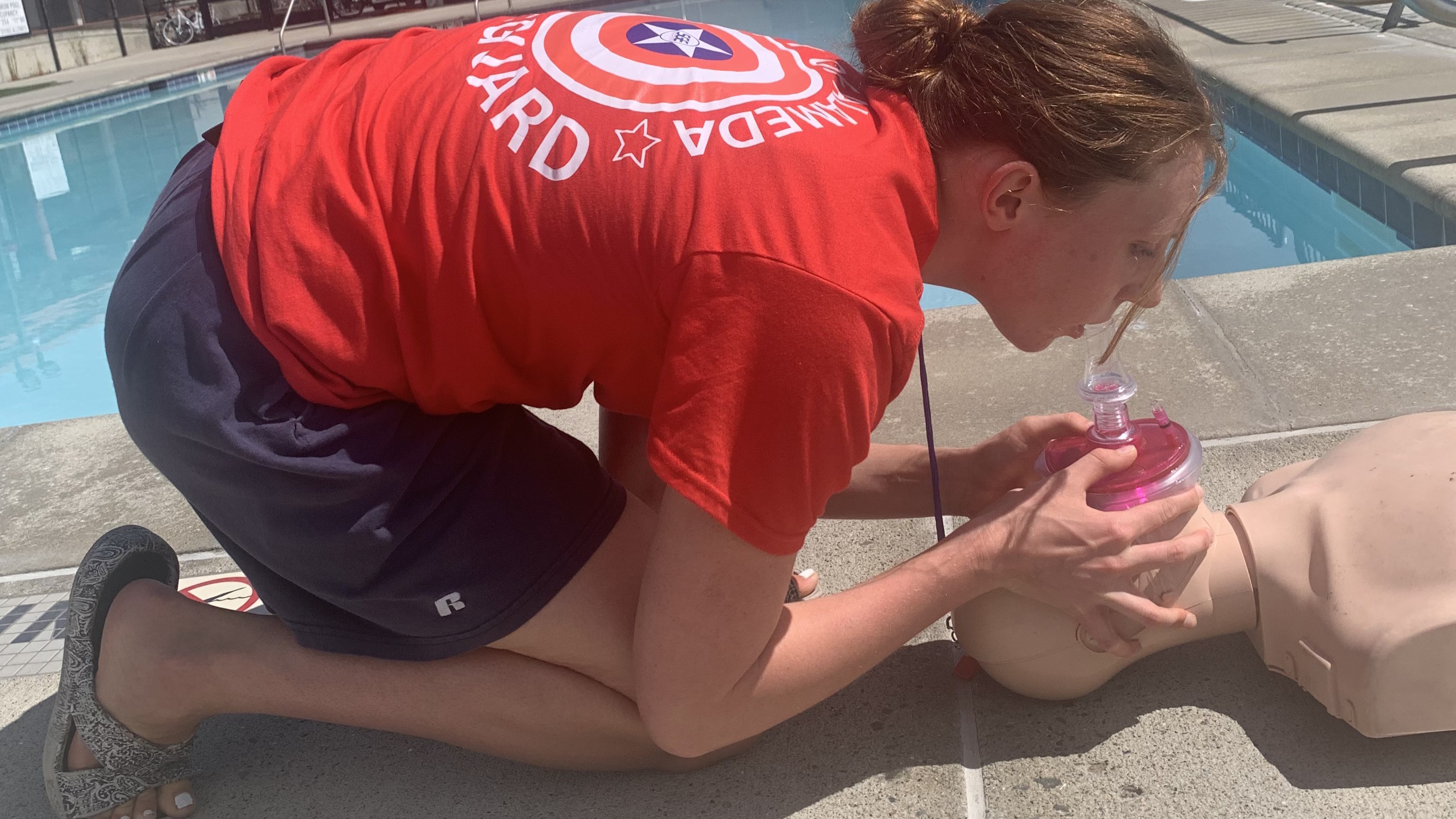A passive submerged victim in deep water who is not moving is a victim in crisis. This victim can’t get to the surface on their own, has a high probability of being unconscious and not breathing, and is fully involved in the drowning process. This victim should receive a full response from your lifeguard team. It should include multiple rescuers initiated and utilized for the rescue, extrication from the bottom of pool to the surface, and removing the victim from the water to the deck, and any necessary medical care. A multi-rescuer response is complicated and requires consistent training on all parts. Communication between rescuers is crucial in developing speed, proficiency and identifying gaps and needs. Below I’ve provided several multi-rescuer drills and how they can have a positive impact on your team.
Note: If either the rescuers or the victim is struggling with equalizing pressure in their ears while underwater, avoid these submerged drills.
MULTI-RESCUER SUBMERGED VICTIM DRILL: Two rescuers are stationed on the deck with rescue tubes, one victim is submerged at a depth of 9-12 feet and located roughly 10 feet from the side of the pool. Both rescuers simultaneously enter the water: Rescuer 1 will do a surface entry (either feet-first or head-first), make contact with the victim and, using a combination of arms and legs, push off the bottom, and push the victim towards the surface. Rescuer 2 will have their rescue tube ready to receive the victim at the surface and immediately secure the victim onto the rescue tube. The victim will be placed into a supine position at the surface with their airway above the surface and open.
Objective: Get the submerged victim to the surface, secured to the rescue tube as quickly and safely as possible.
Timing goal: This drill should be done within 10-15 seconds. When Rescuer 1 is proficient in their role, switch and train in the Rescuer 2 role. Once both lifeguards are proficient in both roles, incorporate these variations, quickly and safely:
• Rescuers will do a staggered entry with a 5-second delay between Rescuers 1 and 2. Once proficient, increase to a 10-second delay.
• Move the victim to 20 feet away from the side of the pool.
• Hard variation − Have Rescuer 2 randomly vary when they arrive to assist Rescuer 1: Simultaneous, 5-second delay, 10-second delay, doesn’t arrive.
This is to train adaptability into Rescuer 1, remembering things don’t always go as planned. The goal is Rescuer 1 will realize Rescuer 2 is delayed or not coming and will secure the victim to the rescue tube and begin towing the victim to the side of the pool.
• In-water ventilation prep — Once Rescuer 1 pushes the victim up to the surface, she or he will get to the surface, gain access to their pocket mask, assemble it, and prepare it for use.
ADVANCED TEAM TOWING DRILL: Builds off the Multi-Rescuer Submerged Victim Drill, both rescuers are at the surface with victim secured to the rescue tube (victim face-up with airway open).
Objective: Get the victim to the side of the pool as quickly and safely as possible.
Timing goal: 5-12 seconds to complete.
Once the rescuers are quick, proficient and synchronized, incorporate these variations:
• Combine Multi-rescuer Submerged Victim Drill with Advanced Team Towing Drill. Start with multi-rescuer submerged victim, bring the victim to the surface and secure them to the rescue tube, transition into advance team towing, and get the victim to the side of the pool. Timing goal: No more than 15 seconds.
• Incorporate in-water ventilations with Advanced Team Towing. Once the victim is secured to the rescue tube, Rescuer 1 prepares the pocket mask and to deliver ventilations. Determine if the team can deliver in-water ventilations while moving victim to the side of the pool. Rescuer 2 will do most of the towing, while Rescuer 1 maintains an open airway on the victim and simulates ventilations. Timing goal: No more than 15 seconds.
EXTRICATION WITH CARE DRILL: Rescuers 1 and 2 are in water at the side of the pool with victim secured to rescue tube. Rescuers 3 and 4 are on the deck with a backboard, ready to extricate.
Objective: Rescuers 1 and 2 transition the victim to Rescuers 3 and 4. Victim is transitioned to the deck, quickly and safely. Rescuers 1 and 2 move to the deck to join in providing care.
Timing goal: 10-12 seconds.
Once the rescue team is proficient, incorporate these variations:
• Rescuers 1 and 2 start 10 feet away from side of the pool with victim secured to rescue tube. Once proficient, increase distance to 20 feet.
• Rescuers 1 and 2 pass victim to Rescuers 3 and 4 who will extricate the victim. Once the victim is handed over to the Rescuers 3 and 4, Rescuers 1 and 2 will exit the water, and prepare to provide the primary assessment.
• Rescuers 1 and 2 pass victim to Rescuers 3 and 4, who extricate victim and begin the primary assessment. Once victim is handed over to Rescuers 3 and 4, Rescuers 1 and 2 exit water, and prepare the BVM, AED, and emergency oxygen.
• Hard variation: Combine Multi-Rescuer, Advanced Team Towing, and Extrication with Care drills. Rescuers 1 and 2 start on the deck with a staggered entry with the victim submerged 20 feet away. Rescuers 3 and 4 are staging with equipment available.
Timing goal: Strive for 15-30 seconds.
Remember, working as a team requires flexibility and great communication.
Have fun, be challenged, and keep training!



